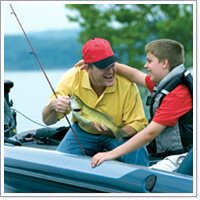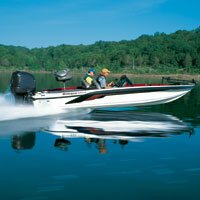Courtesy of TakeMeFishing.org
Before catching fish, anglers must locate them. Unless you live in the middle of the great southwestern deserts there should be a body of fishable water within an hour of your home. You can find fish nearly anywhere there is a body of water large enough to provide food, oxygen and cover. If you have a boat, your choice of angling locations gets even larger.
Where Fish May Be and Why
Not all fish can live in the same kinds of waters. Different species need different sets of environmental conditions, including:
- Hiding areas, cover, structure, and the bottom
- Salinity
- Dissolved oxygen
- Water temperature
- Types and amounts of food
- Current
- Water depth
Structure
Many fish species, such as bass, northern pike, sunfish, and trout, live near structure. Structure refers to changes in the shape of the bottom of lakes, rivers, or ponds, caused by rocks, drowned trees, manmade cribs, flooded roadbeds, humps, ledges, and drop-offs. Structure causes fish to concentrate in certain areas. Lakes and ponds may have shoreline structures such as docks, logs, stump fields, brush, rock piles, grass beds, and downed trees that provide shelter, shade, and protection for fish. Islands, sand bars, rock piles, and log jams in rivers and streams are also good places to fish. Fish inhabit certain types of cover because it provides them with protection and puts them in the best possible position to catch a meal.
Salinity and Oxygen
Some fish species like brook trout cannot live with much salt in the water, other fish, such as tuna and, need salt, and some, such as striped bass, can live in salt or freshwater. Fish also need a certain amount of oxygen in the water. Species such as carp can live on less oxygen than trout. Living plants add oxygen to the water as does moving water tumbling over rocks. Decomposing plants and animals use oxygen from the water and many kinds of pollution also reduce oxygen levels. Thermal pollution may also be a problem as warmer water cannot hold as much oxygen as cold water.
Temperature
Each fish species has a specific range of water temperature that it enjoys. Bullhead catfish can thrive in waters as warm as 85 degrees F, while salmon and lake trout must have cooler 40s and 50s. Some fish tolerate a wide range of temperatures; others have very narrow requirements. Serious anglers find that a thermometer is a useful accessory for knowing when to try for specific kinds of fish.
Food
The amount and type of food available in a body of water plays an important role in determining which types of fish you can hope to catch. The currents and water depth are also significant factors. Scrappy sunfish will haunt shallow riffles while lake trout favor the dark, cold depths. Bass will slam baits on the surface, while carp feed heavily on the bottom.
Visit our freshwater fishing boats page.

